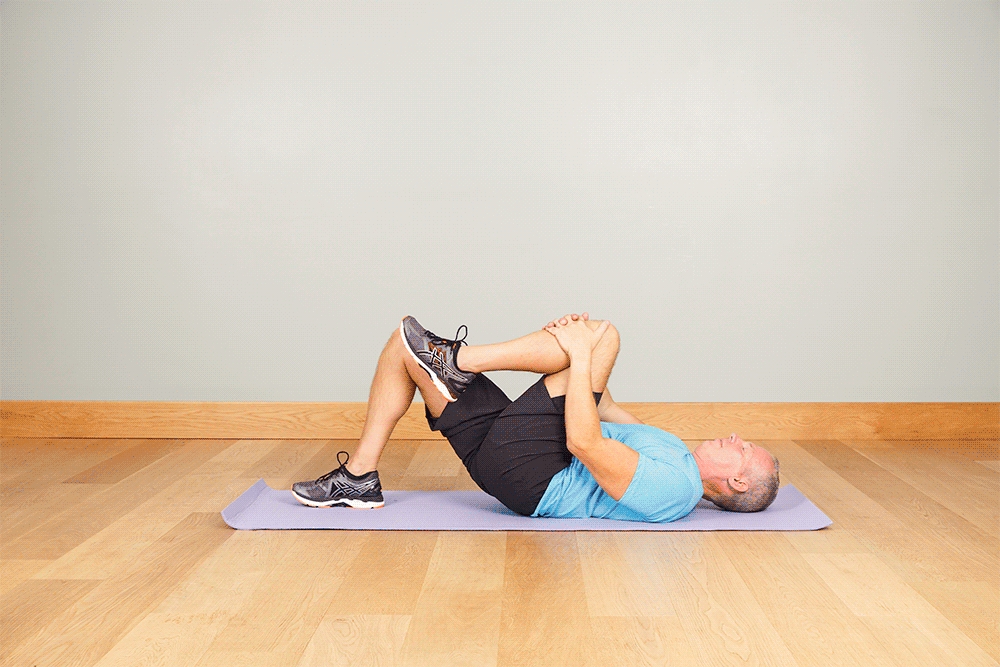Are your hips feeling tight or sore? Do they bother you after going for a run, or after too much lateral movement playing racquet sports?

The normal aging process can increase joint stiffness over time, but much of this can be counteracted with targeted hip exercises. However, they don’t always involve stretching. This might seem counter-intuitive, but if your hip flexors feel tight, aggressively stretching them often doesn’t help, and sometimes makes things worse.
One of the most common factors contributing to tight hips is weak glute muscles, especially in those of us who spend the majority of our time sitting (even if we exercise regularly). The three exercises I describe below decrease hip tightness and strengthen the glutes. (Both hip mobility and lower body strength are predictors of falls in older adults, so you’ll be decreasing your risk by incorporating these moves into your regular workout routine.)
1. Single Leg Glute Bridge
This exercise activates and strengthens the glute muscles, while increasing flexibility in the hip flexors. Knee issues seem to be fairly common in my 55+ clients; this move is a great choice for older adults who want to strengthen (and stretch) their lower body without aggravating their knees.

Bright Photography
Lie on the floor with your knees bent at 90 degrees. Pull your left leg toward your chest, using your arms to hold it in place. Press through your right heel to lift your hips, focusing on using your right glute as much as possible. Make sure your hips are in a straight line with your right knee and your shoulders. Also ensure your lower back doesn’t arch or over-extend. You may feel a stretch in your right hip flexors (pulling your left knee further into your chest can intensify the stretch). Slowly lower and repeat for reps, then switch to the other side. Complete 5 to 10 repetitions on each side.
2. Goblet Squat
Holding a weight in front of your body allows you to sink deeper into a squat than you would if you just used your body weight. In this way, it increases hip mobility. Many of my older clients with lower back pain find goblet squats much more “back-friendly” than squatting while holding a barbell on their backs. Squatting is an important and fundamental movement that improves strength and has excellent carryover into daily movement patterns as well.

Stand with your feet a bit wider than shoulder width, holding a weight (dumbbell or kettlebell) at chest level in front of you. Keeping your chest tall and your back flat, hinge your hips back behind you and bend your knees so your thighs are parallel to the floor. Go as low as you can without pain or discomfort, and without rounding your spine. Press into the floor with your feet to return to standing, and repeat for 3 sets of 10 repetitions.
3. Leg Swing
This hip-opening exercise makes a great warm-up move for your legs as well, especially before lifting weights or before lower body intensive sports (e.g. jogging, hiking, tennis, running after the grandkids).

Stand about two feet in front of a wall or other very stable object. Using a hand on the wall for balance, plant your left foot into the ground, and swing your right leg from front to back. Make sure your left knee doesn’t completely lock out, and that it remains positioned over your left foot (instead of caving inward). Complete 10 repetitions, then switch sides.
Trainer’s Tip
Static stretching to increase hip mobility and decrease tightness is on its way out. Instead, health and fitness professionals are realizing that you can get better results from dynamic movements that take a joint through its full range of motion and more closely resemble movements you’d make in daily life. If you’re feeling hip tightness or pain, I suggest seeing a physiotherapist, who can help you to identify the cause and rule out other possible causes of pain, like arthritis.



